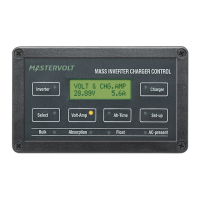28 November 2004 / Masterlink MICC / EN
11 ADDITIONAL INFORMATION
11.1 The Peukert Exponent
Deep cycle battery capacity is usually stated as
a 20-hour discharge rate. A 100 Ah battery will
provide 5A for 20 hours. At discharge rates
above 5A the battery will not supply 100 Ah.
For example: if you are drawing 100A out of the
battery, it will last less than one half-hour.
A scientist named Peukert discovered this in
1897. The Peukert-equation describes the effect
of different discharging rates on the capacity of
a battery. This effect is that with increasing
discharge rate, the capacity of a battery
decreases. Table 3 and the examples give you
an idea of this effect and show how to estimate
a value for the Peukert exponent in your
situation. The Masterlink MICC uses Peukert’s
equation only for the calculation of Time
Remaining. The number in the display (in Ah) is
always the actual number of used Ah.
This means that if you discharge the battery
very fast, the Time Remaining can be zero
before the meter indicates that the total capacity
has been used.
Executing two discharge tests, one at a high
and one at a low discharge rate, which are
about the minimal and maximal discharge rate
for your situation, enables you to calculate a
value “n” for the Peukert exponent which fits
best to your situation. The Masterlink MICC
uses 1.27 as default value for “n”, which will
give good results for most batteries.
At low to moderate discharge rates, around the
20 hr discharge rate, the logarithmic effect of
the Peukert equation is small. At lower
discharge rates the effect is almost linear. For
this reason battery manufacturers specify the
capacity for a 20-hour discharge rate. Peukert’s
equation for battery capacity (Cp) reads:
Cp= I^n * t
log t2 - log t1
where n= ----------------------------
log I1 - log I2
By doing two discharge tests and knowing
I1 and I2 (discharge current in one of the two
tests), and t1 and t2 (time in hours of the two
tests) you can calculate n. For this calculation
you need a calculator that has a logarithmic
function. You can use Table 3 for a better
understanding of the effect of high discharge
rates on the capacity of your batteries. You can
use the table also to make an estimate of “n” of
a battery after only one discharge test. The
values in the table are based on a 100 Ah
battery, but can be used for any capacity you
like by applying the correct ratio
capacity/current. See the examples given.

